January 30, 2014
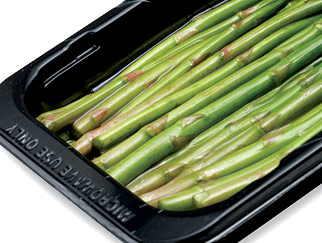
High technology and sustainability won big this year in the 2009 Flexible Packaging Achievement Awards competition, sponsored by the Flexible Packaging Association, (www.flexpack.org). From vacuum skin-packs that protect fresh-cut asparagus and improve the way they’re sold to pouches that use new ways to employ less material and bags with clever new opening features, flexible structures continue to demonstrate their power in changing the face of packaging.
Announced Feb. 25 during the FPA’s annual meeting in Naples, FL, the awards are judged in Packaging Excellence, Printing Achievement, Technical Innovation and Environmental & Sustainability Achievement categories.
The competition included 79 flexible packaging entries submitted out of 113 competition category entries (several packages were entered in multiple categories). Of those, 24 received a total of 26 awards.
Winners earned the Highest Achievement Award, Gold and Silver Awards., while a Special Citation for Social Responsibility was also presented. The seven gold awards, a Highest Achievement winner and a Special Citation for Social Responsibility are presented here. All of the winners, including the Silver Awards, can be found on our website at www.packagingdigest.com.
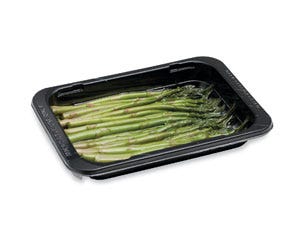
ESL asparagus vacuum-pack
While the traditional method of packaging fresh-cut asparagus for supermarket and grocery-store sales has been to bundle the spears for display and secure them with a rubber band, the Cryovac Food Packaging Div. of Sealed Air Corp. (www.sealedair.com) has a more sophisticated way to keep the green spears fresher longer. The results earned the Highest Achievement Award this year (1) as well as a Gold in Packaging Excellence, and is ranked as having contributed most to the advancement of the industry.
Cryovac says the produce marketplace is changing faster than you can say “arugula.” Demand for fresh-cut fruits and vegetables is driving much of the category’s growth. But these days, value-added produce isn’t inexpensive, so there’s a great need for high-performance packaging that can sustain the quality of a produce investment.
In development for about one year, the package includes a rigid, premade black PP base tray thermoformed by Mullinix Packages (www.mullinixpackages.com) that can contain 8 oz of clean, fresh-cut asparagus that’s vacuumized and skin-packed, which gives it a three-dimensional look. The base tray can be vacuumized on several types of equipment, including Multivac’s (www.multivac.com) T200 tabletop machine and the T350 production vacuum-skin rollstock system.
Southern Specialties, a Pompano Beach, FL grower/processor/importer of a wide range of fruits and vegetables, adopted the vacuum skin-pack about a year ago for asparagus.
The package is part of Cryovac’s existing Simple Steps® microwaveable, self-venting technology (see PD, April 2006, p. 22), but employs a highly permeable, breathable skin film. Cryovac’s Myra Hughes Foster, of new business development, says the film was created to ensure the proper shelf life for fresh-cut vegetables and improve the way asparagus can be prepared. Microwaving takes only two to four min, depending on the desired level of doneness). Thanks to the permeable, 3-mil polyolefin skin film, the package can be displayed vertically for an attention-getting presentation. The vacuum-skin format conforms to the contours of the product, which boosts merchandising appeal.
Depending on produce quality and temperature control, produce in a Simple Steps package typically has a shelf life from 10 to 14 days—substantially longer than fresh asparagus packed conventionally. Foster says that while there’s no modified atmosphere introduced into the package, the product passively modifies the environment via respiration. Oxygen permeates into the package and carbon dioxide (CO2) is dissipated.
The tray-pack allows steam to cook the asparagus in the microwave yet stays cool to the touch when handling so it can be placed on the dinner table. It also needs no venting. As it heats, the film expands, forming a bubble during heating, and then self-vents and relaxes over the produce. Foster says the package can withstand temperatures up to 212 deg F.
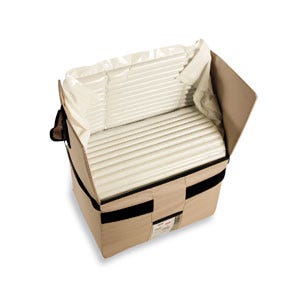 Totable backpack guards vaccines
Totable backpack guards vaccines
A Special Citation for Social Responsibility (2) went to Coldpack System (www.coldpacksystem), San Diego, for a convertible, ecologically friendly package called the AirLiner, an inflatable container developed in part to ship valuable and/or delicate products. Also nabbing a Gold award in Packaging Excellence, the container has an insulating liner that converts the backpack, either with or without a separate, 200#- to 275#-test, corrugated shipping case, into a cooler. The technology allows vaccines to be more easily transported to individual, remote villages.
Shelf life can be greatly impacted by temperature fluctuations. The AirLiner can protect perishables and improve product presentation, shelf life and quality. The nylon backpack holds the AirLiner, which is made from a proprietary laminate that utilizes heat. The heat barrier is both from the thermal conductivity of air or argon gas, which is used to inflate the AirLiner, and the low emissivity metallized films.
The patented technology incorporates layers of a reflective barrier film blend that’s 1 mil in thickness (typically, an AirLiner will have one, three or five layers of this film depending on the desired thickness of the finished product, PD is told) sealed into a proprietary geometry with a honeycomb design that blocks heat transfer, keeping products hot or cold for long periods.
The film comprises an outer structure including a 3-mil nylon coextrusion with PE skin layers and inner films of metallized PE. ISO Poly Films, Inc. (www.isopoly.com) supplies the inner and outer film constructions. Rol-Vac LP (www.rolvac.com) vaccum-metallizes the inner-layer, low-emissivity films. Available in 27 sizes and three thicknesses (¾-, 1-, and 1½-in.), the container is designated as an approved vaccine-transportation system and used by the World Health Organization (WHO), Switzerland.
David McKinney, vp of business development at Coldpack, says WHO estimates that 30 percent of the vaccines bound for developing countries have diminished efficacy, due to poor cold-chain handling. “The AirLiner works by controlling all three modes of heat transfer: conduction, convection and radiation,” McKinney says. “The internal, metallized baffles control radiation using the low-emissivity films.”

A pouch for sandwich bags?
It’s true. An eye-catching, laminated header bag that replaces a paperboard carton and offers a tamper-evident perforation and easy-open features won Gold in Environmental/Sustainability Achievement for S.C. Johnson’s Ziploc® brand of storage bags. Introduced in March 2008, the Bemis® Advance Pak Laminated Rack Header Bag (3), from Bemis Co.’s Polyethylene Packaging Div. (www.bemis.com), took a gold in Environmental & Sustainability Achievement for eco-friendliness and attractive, 8-color reverse-process-printed graphics. Brilliant clarity and high gloss are also characteristics of the bagstock, which replaces a conventional paperboard carton for this kind of product. The bag is made of a stiff, proprietary film that provides durability. The header has a die-cut centered, hanger hole for rack-merchandising display, which allows the package to take up little room on store shelves.
Bemis will only describe the bagstock as being made of the same three-layer, high-clarity PE film lamination as the sandwich bags inside, so it is a monomaterial offering, which Bemis says only adds more green to the greener, lower-cost alternative to a mixed-film laminate. Reverse printing protects the graphics and brand image from scuffing. The bag is sealed on four sides with two fine-weld seals and two fin seals.
Claimed to provide more package rigidity than most conventional PE films, the bag contains 25 sandwich bags. Its bold, reverse-flexo-printed process graphics replicate the Ziploc graphics found on the brand’s paperboard cartons. Bemis says a truckload of the flexible packaging can equal up to 15 truckloads of paperboard material to pack the same amount of product.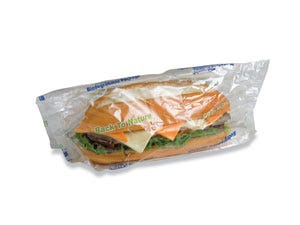 Pouch made from pulp
Pouch made from pulp
The Hot N Handy Bio-Pouch (4), produced by Robbie Mfg., Inc. (www.robbiemfg.com), is a more environmentally friendly take on Robbie’s existing Hot N Handy structure. This version, developed to replace the rigid clamshells in the cold case at convenience-stores, is actually made from renewable wood-pulp.
The bag will degrade, says Robbie’s product manager Tara Downing. According to its life-cycle analysis, using film-production data supplied by Franklin Associates, Ltd., comparing the new flexible pouch with hinged, rigid PS containers, the pouch uses 92 percent less crude oil, reduces CO2 emissions by 56 percent and eliminates 75 percent of the packaging material waste, by weight. The analysis is based on the production of 163 million sandwiches annually for sales retail supermarket deli counters.
Equipped with a built-in gusset that allows it to accept various sandwich sizes, the pouch has a clear resealable adhesive strip for easy opening and a foldover reclosure flap to store leftovers. The pouch material is made using NatureFlex™ biodegradable, compostable film from Innovia Films (www.innoviafilms.com). Taking a Gold in Packaging Excellence, the pouch is surface-printed flexographically with a random four-color repeat graphic indicating the biodegradable/compostable features. It can be custom-sized to fit any size sandwich. “Our initial offering consists of two stock sizes to fit six- and twelve-in. sub sandwiches,” Downing adds.

Expert printing wins the chips
A zippered 10-oz standup pouch for Ghirardelli’s new 100-percent cacao baking chips (5) presents extremely sharp images and colors and clean text, courtesy of gravure printing. American Packaging Corp. (www.ampkcorp.com) grabbed the Gold in Printing Achievement for the luxurious artwork.
The mouth-watering design in a rich, blue, gold and chocolate color scheme and a detailed reproduction were printed in 8 colors with solvent-based inks on a PET/ink/adhesive/metallized PET/LLDPE bagstock, converted at American Packaging’s plant in Columbus, WI. The material is printed on a Cerutti (www.cerutti.it) press and is laminated in-line on a Cerutti laminator.
The results have smoother solids, crisper images and improved aesthetics that are helping to separate Ghirardelli baking chips from the competition.
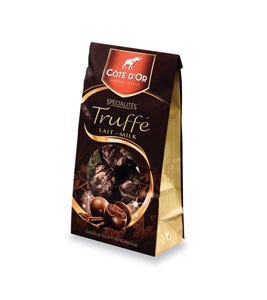
Truffle pack triumph
Also winning a Gold in Printing Achievement is the block-bottom bag for Kraft Foods’ Canada’s Côte d’Or Truffé (individually wrapped milk chocolate truffles) from Amcor Flexibles [www.amcor.com] (6). Available in Austria, Switzerland and France, in this packaging, the premium truffles needed more glamour to jump-start their shelf presence. The side-guesseted film/paper bag features both matte and glossy effects and glitzy foil hot stamping, a tactile feel from embossing under the foil-stamped “Truffé” and “Spécialités” elements and a circular, 40-micron window glued on the inside that shows off the wrapped truffles inside.
Amcor produces and prints the bag at the Flexibles Schroeder & Wagner facility in Rinteln, Germany using (from the outside,) 20-micron OPP laminated to 80 gsm paper and the window film, a 40-micron OPP. Reverse-printed on a Windmöeller & Höelscher (www.whcorp.com) gravure press in 9 colors. The bagstock receives an additional matte lacquer on the outside for extra scratch-resistance. Amcor uses a Siegwerk (www.siegwerk.com) VL TOB ink system and an additional curing process for both the matte lacquer and a paper laminate incorporated into the bag structure.
The front panel carries an image of an African elephant, a symbol of fine chocolate in Belgium, where the fine cocoa for the truffles is sourced.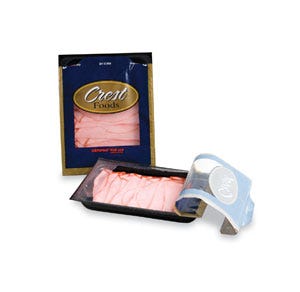
EZO/reclosable deli pack
For Technical Innovation, another Gold winner for Cryovac makes it easy to open and reclose a thermoformed deli meat package repeatedly. The Cryovac® Multi-seal™ (7) works consistently, time after time. Cryovac’s research shows that consumers want easy-open/reclosable packaging and believe that it keeps deli meat fresh. Answering their call, Multi-seal can be opened and resealed at least 10 times, Cryovac says, even through contamination smears.
In development approximately two years, the “rollstock” package comprises a semi-rigid base tray, thermoformed of a proprietary material. It’s mated with a peelable, 5.5-mil barrier-film top web, made by Cryovac of a proprietary material that can be flexo-printed in up to 10 process colors.
Says Tim Avery, marketing director of smoked and processed products, “The package can hold different amounts of product, based on the footprint and depth of the package that the customer wants.”
A clear film viewing window is located on top and a removable tearstrip exposes a tab printed with “lift to open.” The tab can be peeled back like a flap, providing full access to the product. The reclosable flap sticks to a portion of the lidding that remains affixed to the tray.
The base of the top web is sealed to the forming web with a lock-down sealant, Avery explains. “The sealant bonds the top web to the flange of the semi-rigid forming web so that this portion can’t be easily pulled apart.” The package can run on existing thermoforming equipment that evacuates and back-flushes the package to the desired atmosphere. Introduced in June 2008, this Gold winner in Technical Innovation is currently in limited distribution. Expect to see a commercial launch in April 2009, Avery says.
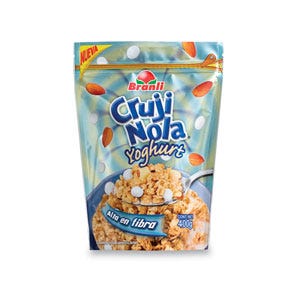
Glitzy granola pouch
A standup pouch for Branli® Cruji Nola granola (8) from Productos Verde Valle, a Mexican processor/distributor of rice, beans and cereals, is available nationally in Mexican supermarkets. The new standup package makes the cereal easy to find in stores and easy to store at home.
Converted by Printpack, Inc.(www.printpack.com) the 400-g zippered pouch presents an all-over vignette of almonds and yogurt-covered raisins floating over a bowl of granola cereal. Bright, bold type calls attention to the cereal’s brand identity.
Printpack produces and 8-color flexo-prints the laminated, three-layer pouchstock with a matte-finished PET outer print layer, a metallized BOPP inner layer (that provides a reflective backdrop for the graphics and adds moisture-resistance) and an LDPE sealant. A Zip-Pak (www.zippak.com) zipper is applied in-line during bagmaking. An unusual visual effect results with the combination of the metallics and the matte-finished PET. Printpack won a Gold award in Printing Achievement.

Gothic label for tanning bronzer
CL&D Graphics (www.cldgraphics.com) won Gold in Printing Achievement for a tanning product label that makes glamorous use of proprietary vacuum spot metallization techniques and what it calls micro/nano technology embossing applied to high-shrink film.
Sunrise, FL-based Performance Brands, Inc. came up with a dramatic bejeweled bottle (9) for Zeda Tanning’s Dark Angel Revealingly Dark Bronzing Intensifier, a tanning-bed lotion that carries the premium shrink label designed with exotic, gothic allure. The purple, gold and black graphics depict illustrations of angels and dragons. The 10.1-oz bottle also has the “bling” of a jewel-topped closure for one eye-popping presentation.
Metallized enhancements are de rigeur for CL&D, so Zeda features translucent water-based inks on a holographic foil/high-shrink PETG base substrate. The sleeve is flexo-printed in rollform in 9 colors plus a UV curing process on a Comco press from Mark Andy (www.markandy.com). One challenge CL&D faced was creating a label with enough oil- and fragrance-resistance to be compatible with the product.
More information is available:
Flexible Packaging Association, 410/694-0800. www.flexpack.org.
American Packaging Corp., 515/73-1407. www.ampkcorp.com.
Amcor Flexibles, 847/362-9000. www.amcor.com.
Bemis Co.’s Polyethylene Packaging Div., 812/460-6200. www.bemis.com.
CL&D Graphics, 262/569-4060. www.cldgraphics.com.
Coldpack System, 858/775-7079. www.coldpacksystem.com.
Cryovac Food Packaging Div., Sealed Air Corp., 846/443-2000. www.sealedair.com.
Printpack, Inc., 404/460-7000. www.printpack.com.
Robbie Mfg., Inc., 913/492-3400. www.robbiemfg.com.
.
About the Author(s)
You May Also Like


